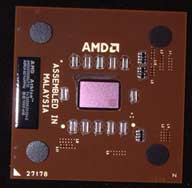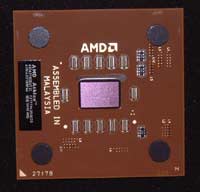AMD AthlonXP 2100+/2000+ Thoroughbred Review
AMD's previous AthlonXP model, the Palomino (0.18 micron process) was
nearing the end
of its competitive life with the release
of AthlonXP 2100+ in March 2002. With AMD's arch rival taking back the performance crown by an almost
800 MHz speed advantage, AMD was beginning to lag behind the performance
curve in the minds of some consumers.
While
the enthusiast community has long known that the Athlon core doesn't need
the high clock speeds a Pentium 4 in order to do the same amount of work, the
general public still remains largely fooled by the MHz-myth. Since it's speed that sells, and since the
Pentium 4 has the performance crown, AMD was set to be overshadowed. The
response to this has
been
the new
AMD Ahthlon XP on
the Thoroughbred core (0.13 micron process). The resulting die shrink should allow the AthlonXP to ramp
up CPU speeds, and thus performance, even though it will still remain
below that of the Intel Pentium 4.


So how does the T-Bred differ from the old Palomino
core? Actually
the T-Bred is basically the Palomino on a shrunken (0.13micron vs.
0.18micron) core!
AMD has refined the core a little now, that is why there
are less transistors. 37.5 million on the Palomino and 37.2 million on the
T-Bred. The actual CPU looks very much like the "Thunderbird" Athlon, with the rectangular
shaped core and resistors on the top instead of on the
bottom.
The
core size is a tiny 80mm2 compared to the much
larger 128mm2 for the Palomino, and 145mm2 of the P4 Northwood (131mm2 for 2.4GHz+). With
the smaller manufacturing process, the T-Bred core doesn't require as much voltage, and more
chips can be cut from the same size wafer. The T-Bred was originally
introduced at speeds from XP1700+ to XP2200+ (1.43 GHz - 1.8 GHz) and the
chart below shows a little diagram explaining the different voltages and thermal
outputs.
Processor
Model |
Operating
Frequency
(MHz) |
Nominal
Voltage |
Typical
Thermal
Power |
Maximum
Thermal
Power |
Typical
Current
Working
State |
Max
Current
Working
State |
Typical
Current
in
Stop
Grant |
Max
Current
in
Stop
Grant |
| 1700+ |
1467 |
1.50V |
44.9W |
49.4W |
29.9A |
32.9A |
2.8A |
4.5A |
| 1800+ |
1533 |
46.3W |
51.0W |
30.9A |
34.0A |
| 1900+ |
1600 |
47.7W |
52.5W |
31.8A |
35.0A |
| 2000+ |
1667 |
1.60V |
54.7W |
60.3W |
34.2A |
37.7A |
3.3A |
5.4A |
| 2100+ |
1733 |
56.4W |
62.1W |
35.2A |
38.8A |
| 2200+ |
1800 |
1.65V |
61.7W |
67.9W |
37.4A |
41.2A |
3.6A |
5.9A |
As we can see, the AthlonXP1700+ to 1900+'s use a voltage
of 1.5V, while the XP2000+ and 2100+ use 1.6V and the current flagship
XP2200+ needs 1.65V.
The T-Bred is still quite a "toasty"
processor, it doesn't give out as much heat as the 1.4 GHz Athlon or XP2100+
(Palomino) but it comes pretty close.

